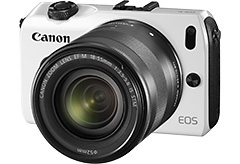In Lesson 13, I will provide an explanation on how shooting at different angles can affect how your photo turns out. If you intend to start using a mirrorless camera, or have just purchased a new camera, this series of articles provide easy-to-understand lessons on techniques for capturing charming photos using the EOS M, which boasts high image quality and simple operability. By learning the basics of cameras and photography, you will be able to produce the shots you want easily! (Photos by: Yuji Ogura, Written & Organized by: Camera Biyori Editorial Department)

Q: How does angle affect the viewer's impression of a photo?
A: "Angle" refers to the orientation of the camera with respect to the subject. The impression of a photo changes depending on the angle from which a subject is captured, such as from the side, diagonally above, or directly above. Let's view some examples of photographing a subject from different angles.
Effects of Angle
Let's learn about the different angles by shooting from the side, diagonally above, and directly above.
From the side

Taking a photo from the side creates a composition that conveys clearly the height of the subject, such as that of a cup. Pay attention to the horizontality of the image to give stability to the image.

Place your camera to the side of your subject. Take note of the depth-of-field (the area that appears to be in focus).
From diagonally above

When the subject is captured from diagonally above, the viewpoint is close to that when we are sitting down, and the resulting image tends to appear natural. Also, this angle makes it easy to capture the entire view of the elements, and their relative positions are also well-defined.

Hold your camera so that the subject is captured from diagonally above. Be sure to hold securely to avoide any camera shakes.
From directly above

Capturing the subject from directly above stresses the shape of the subject, producing a flat and geometric photo. This angle helps to create a well-organised composition even when there are many plates on the table, as illustrated in the example.

Place your camera directly above the subject. Be careful not to include your own shadow in the composition.
Taken from Different "Angles"
Producing shots with a strong impact

A low-angle shot of the pillar of an architectural structure from below. Pointing the camera upward produces a strong impact, and allows one to feel the height of the structure.
Producing geometric shots

This is a shot of an old barrel captured from directly above. Its round shape as well as the horizontal and vertical lines are emphasised.

Canon's first mirrorless camera, the EOS M, comes in four colour variations (black, red, white, and silver) so you can pick your favourite!

Ogura's work in photography expands from shooting photographic works to development and printing films. He is one of the tutors at the "Camera Biyori Photography School". He started his career as an engineer at a film laboratory and later establishes his own "mogu camera" lab. He also runs the "mogu sun" portrait studio.

Camera Biyori is a Japanese photography magazine introducing charming photos and daily joy with cameras. Suggesting fun activities relating to cameras and photography, Camera Biyori editorial department also offer the "Camera Biyori Photography School" to recommend its readers to engage in photography and have fun.
Published by Daiichi Progress Inc.
































